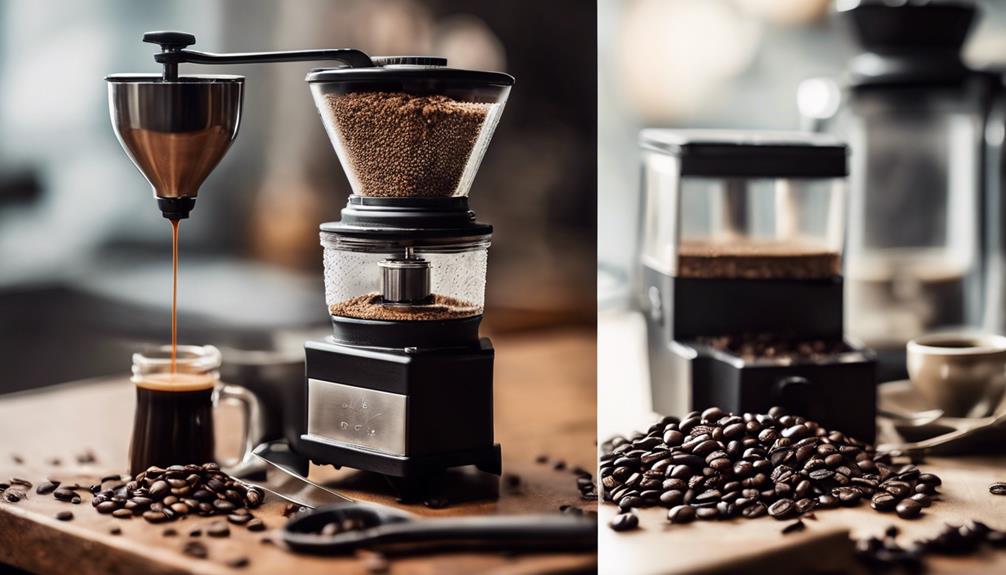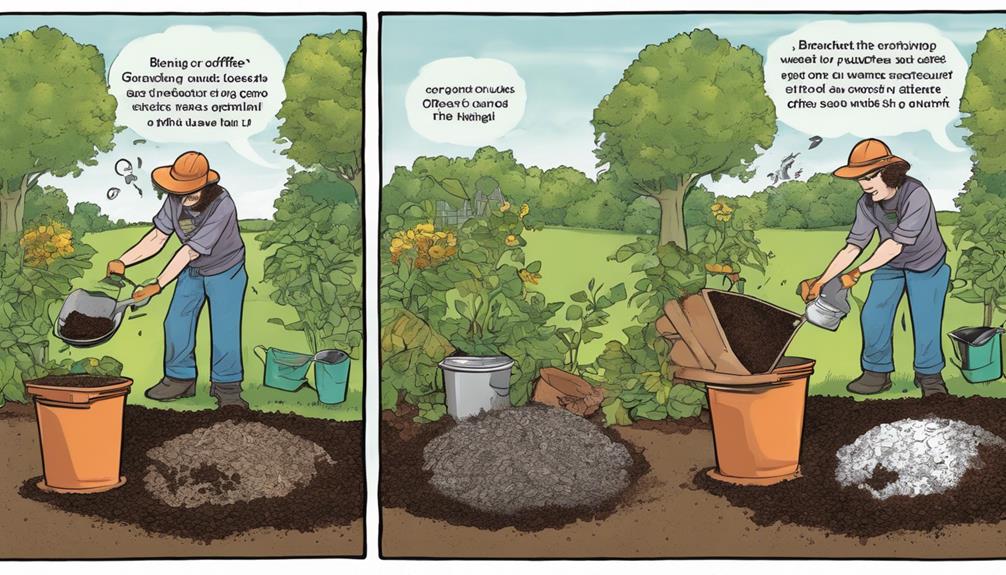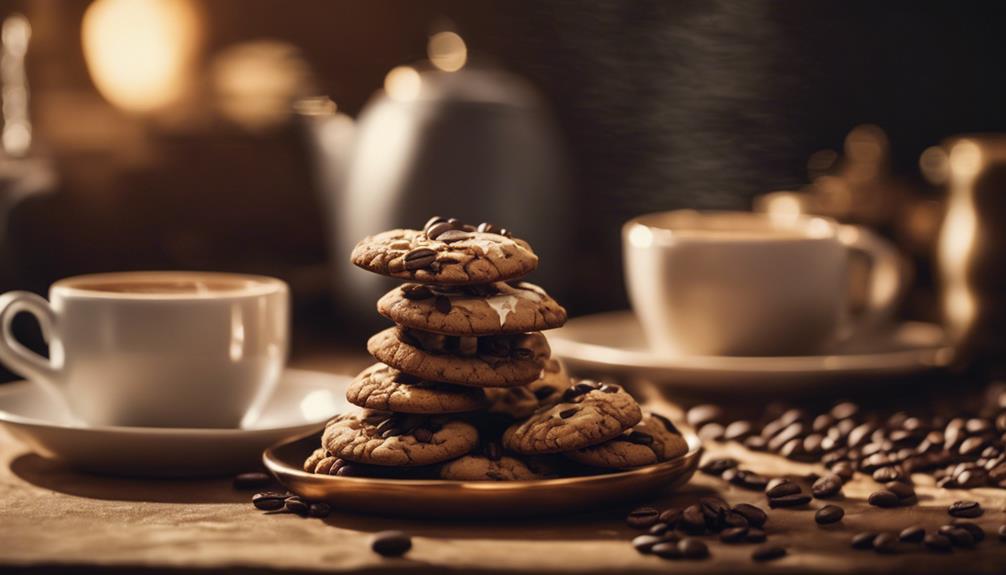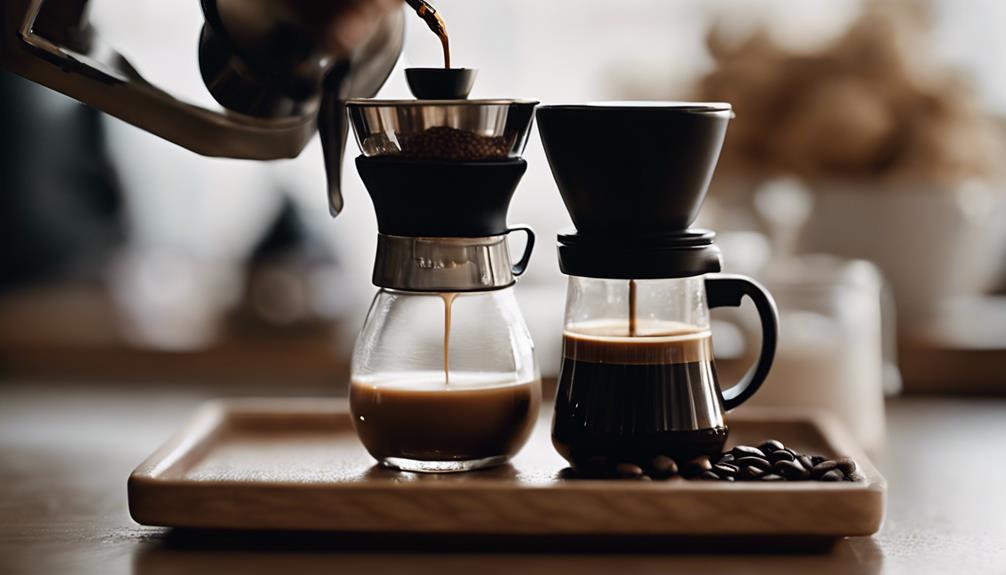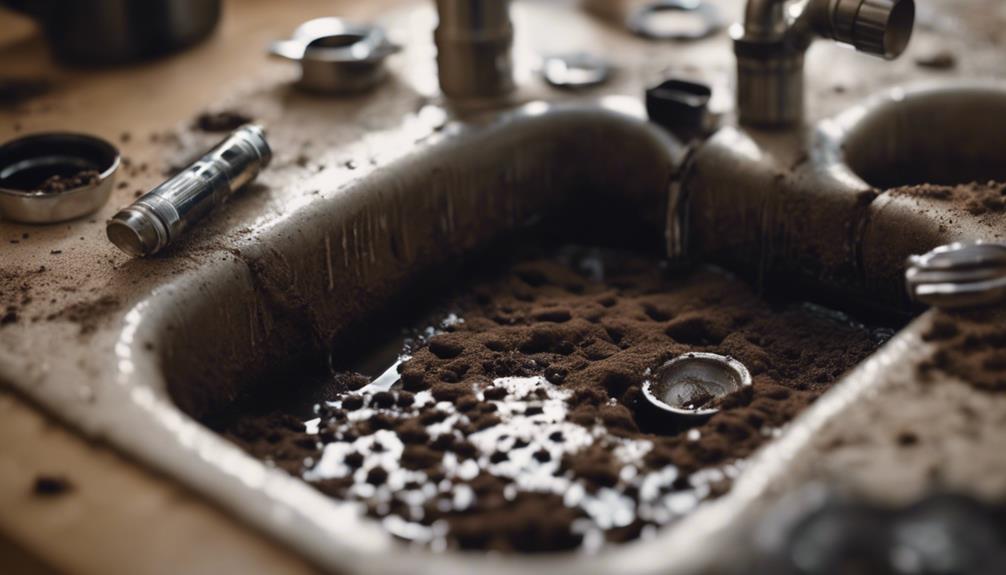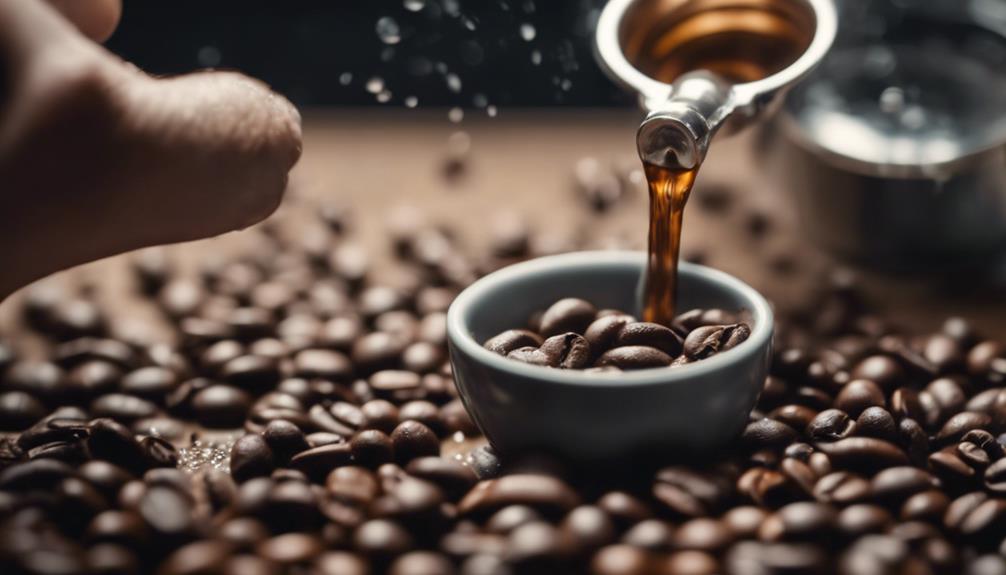You are just one precise grind adjustment away from unlocking the full flavor potential of your espresso beans, and it all begins with mastering the perfect consistency. Achieving uniform grind size is crucial for extraction quality, and paying attention to detail results in flavorful, consistent espresso shots. The ideal grind should resemble powdered sugar to achieve a balanced flavor extraction. Regularly calibrating your grinder is important for different beans and roasts, and choosing burr grinders over blade grinders will bring you closer to perfecting your brew. Now, take the next step towards espresso perfection.
Key Takeaways
- Achieving uniform grind size is essential for balanced flavor extraction and prevents bitter or sour flavors in espresso.
- Prioritize high-quality burr grinders over blade grinders for consistent particle size and flavor enhancement.
- Regular calibration of the grinder is necessary for different beans and roasts to optimize extraction and flavor consistency.
- Monitor extraction times and adjust the grind size accordingly to ensure flavor consistency and prevent channeling or clumping.
Mastering Espresso Grind Consistency
To master espresso grind consistency, you need to understand that achieving a uniform grind size is only the first step, as it's equally essential to maintain that consistency throughout the entire brewing process. You can't just stop at getting the right grind size; you need to make sure it stays that way from start to finish.
A consistent grind size is vital for espresso, as it directly impacts extraction quality. Deviations can lead to bitter or sour flavors due to uneven water flow through the coffee grounds.
To achieve a consistent espresso, you need to aim for a grind that resembles powdered sugar – fine, but not too powdery. This guarantees the right balance of flavor extraction and resistance during brewing. When using the ninja espresso system, it’s important to adjust the grind size to achieve the perfect extraction. Too fine of a grind can result in a bitter and over-extracted espresso, while too coarse of a grind can lead to a weak and under-extracted coffee. By aiming for a grind similar to powdered sugar, you can ensure that the ninja espresso system will extract the optimal flavors from your coffee beans, resulting in a perfectly balanced and delicious espresso.
Regular calibration of your grinder is also necessary, as different coffee beans and roast levels may require adjustments to maintain ideal grind consistency and extraction times. By paying attention to these details, you'll be able to produce a consistent espresso that's full of flavor and free of imperfections.
With practice and patience, you'll be well on your way to mastering espresso grind consistency and enjoying the perfect cup every time. Additionally, experimenting with different types of beans and adjusting the grind size can also help achieve the perfect espresso. It’s important to note that mastering espresso grind consistency takes time and dedication, but the end result is well worth the effort. When comparing vietnamese coffee vs espresso, the grind consistency plays a crucial role in the flavor and overall quality of the final brew. So, keep practicing, stay patient, and soon you’ll be able to confidently make the perfect cup of espresso every time.
Choosing the Right Grinder
You'll greatly upgrade your espresso game by selecting a grinder that can deliver a precise, consistent grind, which is where the right equipment comes in.
When it comes to choosing a grinder, prioritize burr grinders over blade grinders. Burr grinders guarantee a consistent particle size, which is essential for ideal extraction. High-quality grinders like the Eureka Atom Specialty 75 can greatly enhance grind consistency and overall espresso flavor.
When selecting a grinder, consider one with a stepless adjustment feature. This allows you to fine-tune the grind size to accommodate different beans and extraction preferences.
Remember, investing in a reliable grinder often yields a greater improvement in espresso quality than spending on an expensive espresso machine.
To maintain your grinder's performance and guarantee the freshness of each brew, regular maintenance is vital. Clean your grinder regularly and replace the burrs as needed.
Avoiding Common Grinding Errors
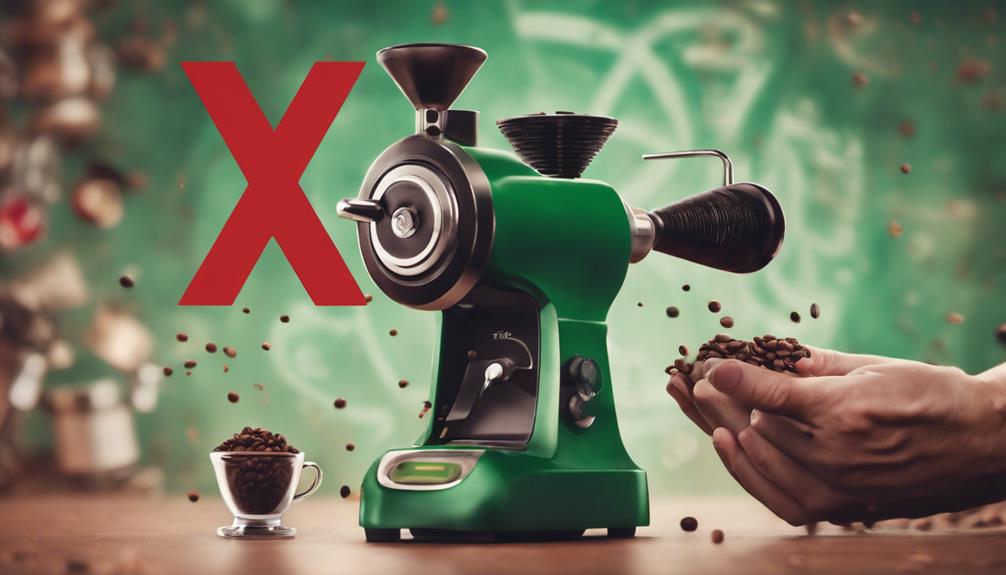
One common pitfall many espresso enthusiasts fall into is producing inconsistent grinds, which can be a major obstacle to achieving perfect shots. To avoid this, you'll want to guarantee you're using a burr grinder instead of a blade grinder, as blade grinders produce uneven particle sizes leading to inconsistent extraction and flavor issues.
You should also regularly calibrate your grinder settings and adjust based on the type of beans and their roast levels to achieve the ideal grind consistency required for espresso.
When grinding your coffee, use the pinch test to check for clumping; if your grounds stick together, it indicates poor grind quality that can lead to channeling and uneven extraction.
Additionally, maintain clean equipment by regularly flushing your grinder with beans to prevent stale grinds from contaminating fresh coffee.
As you brew, monitor extraction time closely, as deviations can highlight grind inconsistencies; aim for a standard extraction time of 25-30 seconds for excellent results.
Calibration and Maintenance Tips
By maintaining your grinder's ideal performance through regular calibration and upkeep, you're ensuring that every shot you pull benefits from a precise and consistent grind.
To achieve this, regularly calibrate your grinder settings to accommodate different beans and roast levels, optimizing extraction. Perform routine maintenance on your burr grinder by cleaning it to remove stale grinds and replacing burrs every few months or after grinding a considerable amount of coffee. This will prevent any buildup from affecting your grind quality.
Use a stepless adjustment grinder to fine-tune your espresso grind according to specific shot requirements. Additionally, implement the pinch test to check for clumping, indicating the need for maintenance or adjustment in grind consistency before brewing.
Monitor extraction time closely and make incremental grind adjustments, as even slight deviations can considerably impact flavor and shot quality.
Troubleshooting Extraction Issues
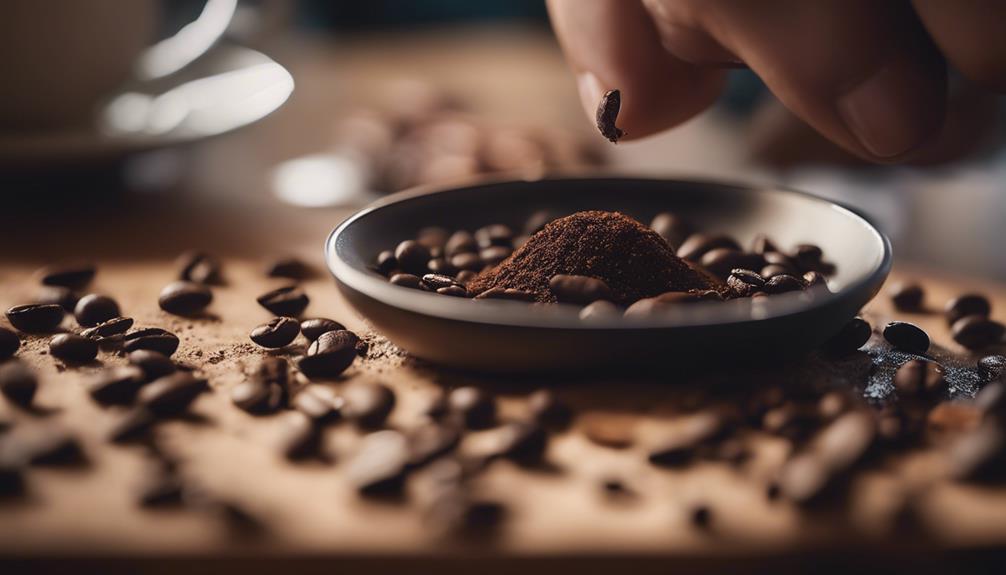
As you troubleshoot extraction issues, you'll likely encounter channeling and clumping, which can lead to uneven flavor profiles.
By inspecting the espresso puck and monitoring extraction times, you can identify areas where grind size adjustments are necessary.
Now, let's explore how to tackle these common problems and achieve the perfect balance in your espresso shots.
Channeling and Clumping
When you're struggling to achieve perfect flavor extraction, channeling and clumping are two common culprits that can sabotage your espresso shots, leading to sour flavors and inconsistent results.
Channeling occurs when water flows unevenly through the coffee grounds, resulting in under-extraction and a sour flavor. Clumping, on the other hand, causes uneven water distribution, leading to inconsistent extraction.
To combat clumping, try employing the Weiss Distribution Technique (WDT) by stirring the grounds in the portafilter to guarantee an even distribution before tamping.
After brewing, inspect the puck for signs of channeling, such as uneven holes or dry patches. This can indicate that your grind size or tamping technique needs adjustment.
Using a bottomless portafilter can also help you visualize channeling during extraction, allowing you to fine-tune your grinding and tamping methods.
Remember to regularly calibrate your grinder settings, as different beans and roast levels may require adjustments to prevent channeling and clumping for peak flavor extraction.
Grind Size Adjustments
You'll need to make precise grind size adjustments to troubleshoot extraction issues, since even a slight deviation can greatly impact the flavor of your shot. A finer grind can lead to over-extraction and bitterness, while a coarser grind may result in under-extraction and sourness. To avoid these issues, utilize the pinch test to assess grind quality; if clumping occurs, it indicates inconsistency that can negatively impact flavor.
Continuously monitor extraction time, targeting 25-30 seconds for best results, and adjust grind size accordingly based on observed flavors. If your shot is too bitter, try a slightly coarser grind. If it's too sour, try a slightly finer grind.
Employ the Weiss Distribution Technique (WDT) to combat channeling by stirring the grinds in the portafilter, ensuring even distribution before tamping.
Regularly calibrate grind settings based on the freshness and roast degree of the beans, as different types may require unique adjustments for perfect extraction.
The Importance of Fresh Beans
As you explore the world of espresso, you'll soon realize that using fresh beans is essential to achieving a rich and complex flavor profile.
The roast date of your beans has a significant impact on the final taste, and proper storage techniques can make all the difference in preserving their freshness.
Bean Freshness Matters
Roasting freshness plays a significant role in revealing your espresso's full flavor potential, and using freshly roasted beans is vital to achieving a rich and vibrant taste profile.
You'll want to use your beans within 2-4 weeks of roasting to guarantee peak freshness and flavor. Storing them in an airtight container away from light, heat, and moisture will help maintain their freshness. Grinding fresh beans just before brewing is also important, as pre-ground coffee can lose flavor quickly, leading to inconsistent and less vibrant espresso shots.
When working with freshly roasted beans, you'll need to evaluate grind adjustments based on the roast degree. Lighter roasts often require finer grinds to achieve peak extraction, while darker roasts may need coarser settings to avoid over-extraction.
Roast Date Impact
Check the roast date on your beans, because the clock starts ticking immediately after roasting, and the quality of your espresso hangs in the balance. Freshly roasted beans are essential for ideal flavor and grind consistency. As beans age, they lose carbon dioxide, which affects extraction and flavor. Beyond two to four weeks, beans can become stale, leading to poor crema quality and unbalanced flavors.
| Time Post-Roasting | Bean Quality | Grind Consistency |
|---|---|---|
| 0-2 weeks | Ideal flavor, high CO2 | Even particle size, minimal clumping |
| 2-4 weeks | Balanced flavor, moderate CO2 | Slightly uneven particle size, some clumping |
| 4-6 weeks | Stale flavor, low CO2 | Inconsistent particle size, excessive clumping |
| >6 weeks | Unpleasant flavor, very low CO2 | Unpredictable grind, significant clumping |
Using freshly roasted beans allows you to control flavor profiles and consistency in your espresso preparation. Regularly sourcing high-quality beans guarantees you're getting the best possible flavor and grind consistency. Don't compromise on freshness – your espresso deserves the best.
Storage Techniques
You've got the perfect roast date locked down, now it's time to focus on preserving that freshness with proper storage techniques.
To maintain the flavor and aroma of your coffee beans, it's crucial to store them in an airtight container, away from light, heat, and moisture. As a general rule, use your coffee beans within two weeks of roasting for maximum freshness and flavor.
Whole beans are your best bet, as they stay fresh longer than pre-ground coffee, which can lose its flavor quality within days of grinding. For long-term storage, consider freezing coffee beans in small, vacuum-sealed bags, but avoid repeated thawing to prevent moisture absorption.
Always label your storage containers with the roast date to keep track of freshness and confirm you use your beans within their prime flavor window.
Grinder Upgrades and Accessories
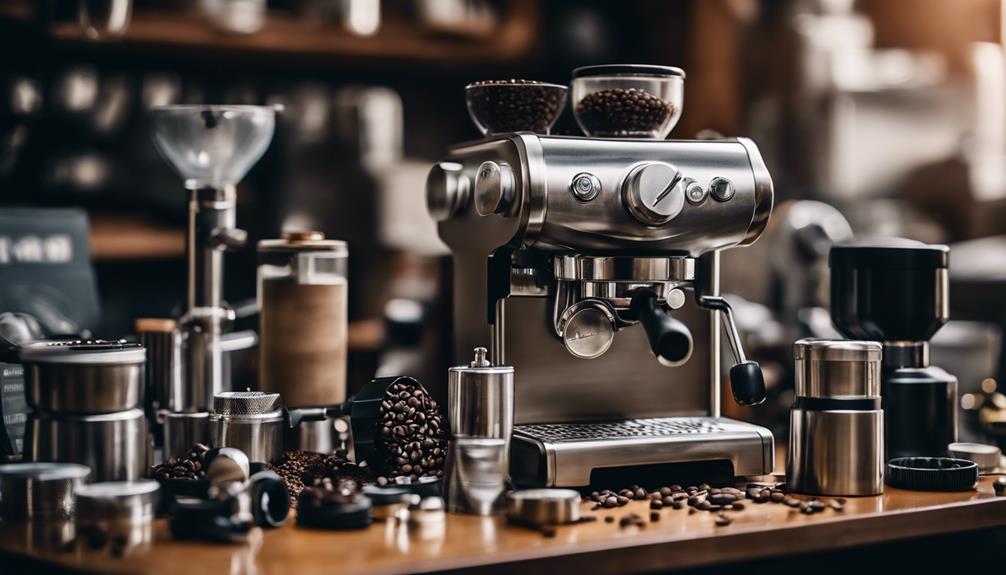
Upgrading your grinder to a high-quality burr model, like the Eureka Atom Specialty 75, can be a game-changer for achieving consistent espresso grinds. This upgrade can considerably enhance the quality of your espresso by providing a more precise grind, which is vital for ideal extraction. With a high-quality grinder, you'll be able to achieve a consistent grind size, which is fundamental for producing high-quality espresso.
In addition to grinder upgrades, there are several accessories that can help you refine your espresso-making skills. For instance, a bottomless portafilter allows you to observe extraction quality in real-time, helping you identify and address channeling issues effectively.
A PID machine, like the Izzo Vivi, guarantees stable brewing temperatures, which is essential for maintaining the desired flavor profile in espresso. Furthermore, scales like the Hario Drip Scale or the faster Acaia Lunar provide precise measurements for dose and output weight, enabling consistent brew ratios vital for espresso extraction.
Perfecting Your Brewing Technique
Mastering the art of brewing espresso requires attention to detail, and one crucial aspect is developing a consistent technique to guarantee ideal extraction.
You've got your espresso machine and freshly ground coffee, now it's time to perfect your brewing technique. Start by confirming you're using the right amount of coffee – typically around 14-17 grams of coffee for a double shot.
Next, adjust your grind size based on the type of coffee beans you're using, as lighter roasts require finer grinds. When tamping, apply around 30 pounds of pressure to assure even extraction.
Now, it's time to brew. Aim for a brewing time of 25-30 seconds, with a coffee-to-water ratio of 1:2. As you brew, pay attention to visual indicators like a honey-like flow and the presence of rich crema, which indicate ideal extraction.
Achieving Consistent Flavor Profiles
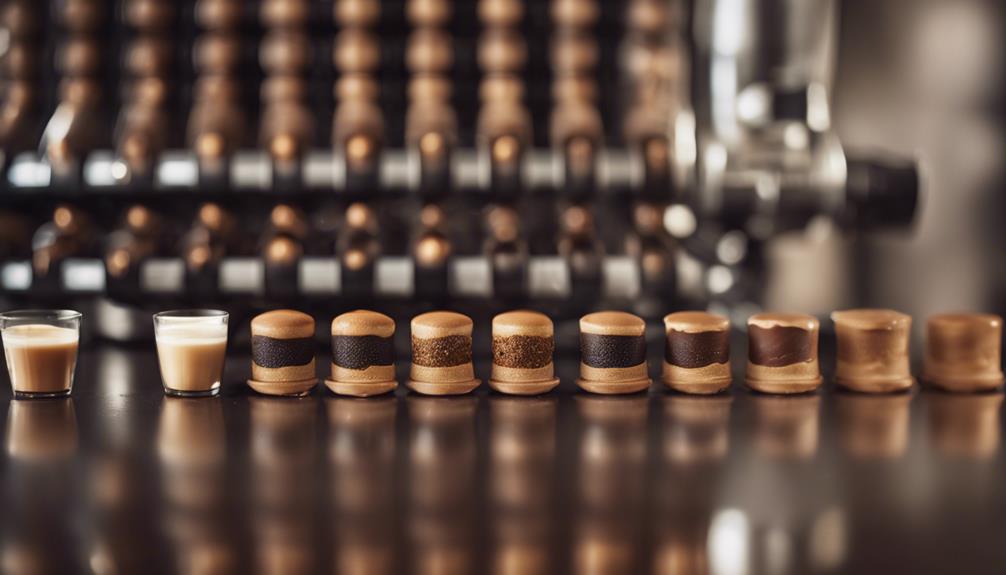
As you endeavor to perfect your espresso brewing technique, achieving consistent flavor profiles relies heavily on a combination of precise grind sizes, ideal coffee-to-espresso ratios, and controlled tamping pressure.
To get it right, you'll need to focus on the following key factors:
| Parameter | Target Value |
|---|---|
| Grind size | 4.2-second grind time |
| Coffee-to-espresso weight ratio | 1:2 (18-20g coffee : 36-40g espresso) |
| Tamping pressure | 30 pounds |
Frequently Asked Questions
How to Get Consistent Espresso Shots?
You're wondering how to get consistent espresso shots? Start by using a high-quality burr grinder to guarantee uniform particle size, then calibrate settings based on bean type and roast, and don't forget to tamp with 30 pounds of pressure.
What Should Be the Consistency of an Espresso Grind?
You're looking for the perfect grind consistency – it should be very fine, similar to powdered sugar, but not too powdery, with a slightly gritty texture that allows for ideal extraction and balanced flavor.
What Does Perfect Espresso Grind Look Like?
When you achieve a perfect espresso grind, it resembles powdered sugar, with particles so fine they're almost dust-like. You'll notice a uniform consistency, which guarantees ideal extraction and a rich, velvety crema on your shot.
How Do You Make Coffee Grind Consistent?
You guarantee a consistent coffee grind by investing in a high-quality burr grinder, regularly calibrating it, and using techniques like WDT to minimize clumping, resulting in uniform particle sizes.
Conclusion
You've finally got the hang of it – mastering espresso grind consistency is a piece of cake!
Now, it's time to 'rise to the occasion' and take your brewing skills to new heights.
With practice and patience, you'll be whipping up perfect shots like a pro.
Remember, consistency is key, so stay on top of your game and keep those grinds just right.
Happy brewing!
